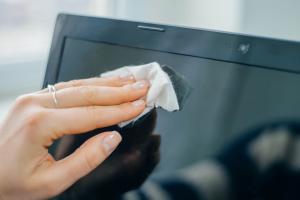Ultimate Guide to Cleaning Your Computer Screen & Removing Scratches

-
Quick Links:
- Introduction
- Why Cleaning Your Computer Screen is Important
- What You Need to Clean Your Screen
- Step-by-Step Cleaning Guide
- How to Remove Scratches from Your Screen
- Common Mistakes to Avoid
- Pro Tips for Maintaining Your Screen
- Case Studies & Examples
- FAQs
Introduction
Cleaning your computer screen is essential not only for aesthetics but also for functionality and longevity. Over time, screens accumulate dust, fingerprints, and smudges that can impair your viewing experience. In addition, scratches can occur, leading to further frustration. This guide aims to provide you with comprehensive strategies for cleaning your computer screen effectively and safely while also addressing how to remove scratches.
Why Cleaning Your Computer Screen is Important
Regular cleaning of your computer screen can:
- Enhance visibility and clarity.
- Prevent dust buildup that can affect hardware performance.
- Improve overall hygiene, especially in shared workspaces.
- Extend the lifespan of your device.
What You Need to Clean Your Screen
Before diving into the cleaning process, ensure you have the following materials:
- Microfiber cloth
- Screen-safe cleaning solution (distilled water, isopropyl alcohol, or commercial screen cleaners)
- Spray bottle (if using a homemade solution)
- Soft brush or compressed air (for dust removal)
Step-by-Step Cleaning Guide
Step 1: Power Down Your Device
Always turn off your computer and unplug it before cleaning. This prevents any potential damage and allows you to see the dirt and smudges more clearly.
Step 2: Dusting the Screen
Using a soft brush or compressed air, gently remove any dust particles from the screen surface. This minimizes the risk of scratching during the cleaning process.
Step 3: Preparing Your Cleaning Solution
If you're opting for a homemade cleaning solution, mix equal parts distilled water and isopropyl alcohol in a spray bottle. Avoid using harsh chemicals that can damage the screen.
Step 4: Applying the Cleaner
Lightly spray your cleaning solution onto the microfiber cloth. Never apply the cleaner directly to the screen. This prevents excess liquid from seeping into the edges of the screen, which can lead to damage.
Step 5: Wiping the Screen
Using the damp cloth, gently wipe the screen in circular motions. This technique ensures that you cover the entire surface without pushing dirt into the edges.
Step 6: Drying the Screen
After cleaning, use a dry section of the microfiber cloth to wipe the screen again, ensuring no streaks are left behind.
How to Remove Scratches from Your Screen
Scratches can be a significant nuisance. Here are methods to attempt scratch removal:
Method 1: Toothpaste Remedy
Toothpaste can be an effective abrasive for minor scratches. Apply a small amount of non-gel toothpaste on a soft cloth and gently rub it over the scratch in a circular motion.
Method 2: Baking Soda Paste
Mix baking soda with water to create a paste. Apply it similarly to the toothpaste method. Make sure to wipe the area clean afterward.
Method 3: Commercial Scratch Removers
Consider using commercial products designed specifically for electronic screens. These often provide a more controlled solution.
Common Mistakes to Avoid
While cleaning your screen, be cautious of the following:
- Using paper towels or rough fabrics that can scratch the screen.
- Applying too much pressure while cleaning.
- Using products with alcohol or ammonia that can damage coating.
Pro Tips for Maintaining Your Screen
- Clean your screen regularly to avoid buildup.
- Use a keyboard cover to prevent dust from settling on the screen.
- Invest in a good quality screen protector to minimize scratches.
Case Studies & Examples
Many users have reported improved screen visibility and device longevity through regular cleaning practices. For instance, a survey by MIT Technology Review indicated that 65% of participants noticed a significant improvement in their overall computer performance after maintaining a regular cleaning schedule.
FAQs
1. How often should I clean my computer screen?
It's recommended to clean your screen at least once a week, or more often if you notice dust and smudges.
2. Can I use vinegar to clean my screen?
While vinegar is a natural cleaner, it can be too harsh for some screens. It's best to stick with screen-safe solutions.
3. What should I avoid when cleaning my screen?
Avoid using paper towels, ammonia-based cleaners, and excessive pressure while cleaning.
4. Are commercial screen cleaners safe?
Most commercial screen cleaners are safe as long as they are specifically designed for electronic screens.
5. Do screen protectors help prevent scratches?
Yes, screen protectors can significantly reduce the risk of scratches and help maintain the clarity of your screen.
6. How do I know if my screen has a protective coating?
Most modern screens do have protective coatings, but if you're unsure, consult your device's manufacturer specifications.
7. Can I use baby wipes to clean my screen?
It's not advisable as many baby wipes contain chemicals that can damage the screen.
8. Is it safe to use a microfiber cloth for cleaning?
Yes, microfiber cloths are ideal as they are soft and non-abrasive.
9. How can I prevent scratches on my screen?
Avoid placing heavy objects on your laptop and use a screen protector for added safety.
10. What if my scratches are deep?
For deeper scratches, consider professional help or using specialized products designed for scratch removal.
Random Reads
- Dark mode google docs
- Creative diy rope baskets
- Fix dell laptop black screen
- Find your skype id
- Best way to hang frameless mirror flat back
- How to download android apps complete guide
- Uninstall icloud windows
- Uninstall internet explorer
- Summon herobrine minecraft pe mod
- How to add a lean to onto a shed